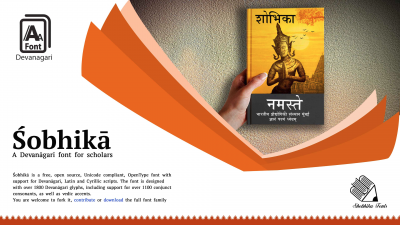
The Cell for Indian Science and Technology in Sanskrit (CISTS) at IIT Bombay investigates the scientific literature extant in the Sanskrit language, and publishes the findings in a way that is palatable to a modern reader. In pursuit of our work at CISTS, we have long felt hampered by the limited tools available for the typesetting and
publishing documents in the Devanagari script,as the work was carried out using a sub-optimal combination of proprietary and/or open source tools lacking full Unicode compatibility for a lack of better options. The documents thus prepared could not be easily shared among scholars, nor readily searched.
As we decided to move to the free, open source, and fully Unicode compliant XeTeX typesetting system to circumvent this problem, it was realised that the available Devanagari fonts had deficiencies that included any or all among:
■Poor support for conjunct characters
■Unaesthetic rendering of Vedic accents
■Lack of cross platform compatibility
■Availability in only a single weight, and
■Missing or poor quality companion Latin font.
In addition, font hinting, kerning, and other typographic flourishes were almost entirely missing from many Devanagari fonts. To address these issues, CISTS took the lead to develop a new font, in collaboration with designers at the Industrial Design Centre, IIT Bombay. To make this mammoth undertaking more
manageable, we decided to base our work on two existing fonts: (i) Yashomudra (for Devanagari) by Rajya Marathi Vikas Sanstha, and (ii) PT Serif (for Latin) by ParaType. The Shobhika font is built upon these two fonts.
The main features of Shobhika:
1. Outstanding support for Devanagari conjuncts While the Western typographer has to typically design only a base set of characters in lower and upper case, the Devanagari type designer has to design for the seemingly countless number of conjunct characters that arise by the combination of two, three, four, or even five consonants. Most Devanagari fonts however ship with only a couple of hundred glyphs to cater to the most commonly occurring conjunct characters. When the end user attempts to type any character which is not
included, the font compensates by breaking the conjunct character, which is not desirable. To address this issue, we identified well over 1100 conjunct characters in various Sanskrit texts. The unique characters from this list were added to the base Yashomudra font. In addition, the font also inherits from Yashomudra certain conjunct
characters found in languages like Marathi and Urdu, or those required for transliteration of English words into Devanagari. We further designed the ‘ि ’ and ‘ ी’ matras in multiple widths to ensure that they sit properly on conjunct characters of various widths, and also combine appropriately with marks like repha, chandrabindu, etc. Numerous other improvements, too long to list here, have been made to ensure a quality and bug- free experience.
2. Support for a wide range of Vedic accents
Correct pronunciation and proper intonation are extremely critical in the study of the vedas. Therefore, Vedic Sanskrit - unlike classical Sanskrit - makes use of a variety of accent marks (svara) in combination with characters to denote the proper intonation required at each place. The implementation of Vedic accents in fonts is
complicated because the svaras compete for the limited space available above and below a given character with a variety of other matras, or marks like the repha or vattu. Shobhika addresses many of these challenges, and supports a wide variety of Vedic accents and nasalisation marks.
3. Cross-platform compatibility
Historically, different operating systems like Windows, macOS and Linux have used their own schemes for the input and display of text on the computer. However, recently, all major operating systems have moved to a single scheme following the establishment of the Unicode standard. Shobhika supports almost all Devanagari characters defined by Unicode, except for a few accents and cantillation marks required for Samaveda. The font has been developed using the modern OpenType format, and works across Windows, macOS, and Linux in all Unicode compliant applications such as MS Office, Libre Office, and XeTeX. Installing Shobhika on any computer is as simple as downloading and double clicking the font.
4. Availability in two weights
Many Sanskrit works are typically typeset in two weights, either to distinguish the original work and a commentary on the same page, or to differentiate specific words and their meanings while explaining the import of the original text in the commentary. Keeping this requirement in mind, Shobhika has been designed in two weights
(regular as well as a bold).
5. Good quality companion Latin font
As English is the lingua franca of academic research, scholars across the world have to prepare multi-lingual documents. The Latin component of Shobhika is based on the PT Serif typeface designed by ParaType, which was specifically chosen for its compatibility with the Devanagari component on a number of design parameters,
resulting in a harmonious appearance on the page. We have extended the Latin component with a variety of mathematical symbols and diacritic characters to cater to a wider range of scholarly requirements, and to offer better support for Roman transliteration of Devanagari. ParaType shipped PT Serif with in-built support for the Cyrillic script, and Shobhika too retains this functionality.
Reception and Recognition:
The font has been received enthusiastically by a wide spectrum of academics. In particular, we have received appreciations both from the students and scholars of Sanskrit across the globe.As a representative sample, we quote below the message received (by e-mail) from a world renowned scholar in the area of Sanskrit grammar and linguistics, Emeritus Prof. George Cardona, U. Penn, “This is truly an excellent font, which I have now adopted as the single font I will use in my work on Panini and other Sanskrit works.”
For downloading and other details:
https://github.com/Sandhi-IITBombay/Shobhika
Prof. K Ramasubramanian Prof. Girish V Dalvi
